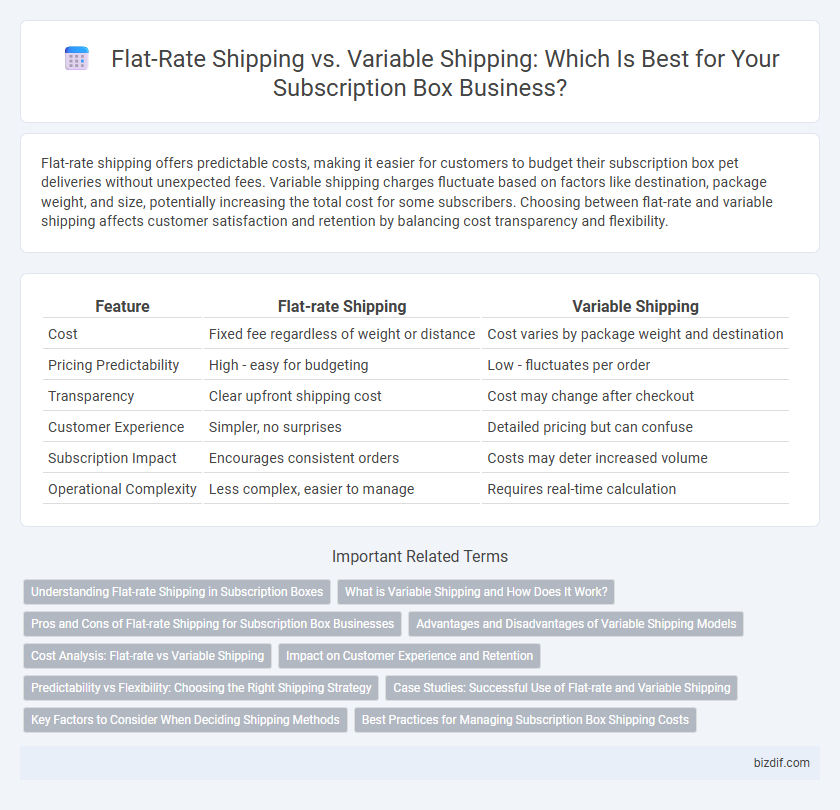Flat-rate shipping offers predictable costs, making it easier for customers to budget their subscription box pet deliveries without unexpected fees. Variable shipping charges fluctuate based on factors like destination, package weight, and size, potentially increasing the total cost for some subscribers. Choosing between flat-rate and variable shipping affects customer satisfaction and retention by balancing cost transparency and flexibility.
Table of Comparison
| Feature | Flat-rate Shipping | Variable Shipping |
|---|---|---|
| Cost | Fixed fee regardless of weight or distance | Cost varies by package weight and destination |
| Pricing Predictability | High - easy for budgeting | Low - fluctuates per order |
| Transparency | Clear upfront shipping cost | Cost may change after checkout |
| Customer Experience | Simpler, no surprises | Detailed pricing but can confuse |
| Subscription Impact | Encourages consistent orders | Costs may deter increased volume |
| Operational Complexity | Less complex, easier to manage | Requires real-time calculation |
Understanding Flat-rate Shipping in Subscription Boxes
Flat-rate shipping in subscription boxes offers a consistent, predetermined shipping cost regardless of order size or weight, simplifying budgeting for customers. This method enhances transparency and reduces surprises, making it easier for subscribers to manage their expenses over time. Businesses benefit from streamlined logistics and predictable revenue, supporting efficient inventory and cost management.
What is Variable Shipping and How Does It Work?
Variable shipping adjusts costs based on factors such as package size, weight, destination, and delivery speed, ensuring customers pay precise fees for their subscription boxes. This method optimizes shipping expenses by calculating charges dynamically for each order rather than applying a fixed rate, enhancing fairness and cost efficiency. Retailers leveraging variable shipping can better manage logistics and improve customer satisfaction by aligning shipping costs with actual delivery requirements.
Pros and Cons of Flat-rate Shipping for Subscription Box Businesses
Flat-rate shipping simplifies billing and enhances customer satisfaction by offering predictable costs regardless of box size or weight, aiding subscription box businesses in managing logistics and reducing cart abandonment. However, it may result in higher expenses for heavier or bulky shipments, potentially squeezing profit margins if shipping costs exceed the flat fee. Businesses must carefully analyze average box weights and shipping zones to determine if flat-rate shipping aligns with their financial and operational goals.
Advantages and Disadvantages of Variable Shipping Models
Variable shipping models adjust costs based on package size, weight, and destination, providing flexibility and potentially lowering shipping expenses for smaller or local orders. This approach allows subscription box businesses to align shipping fees more closely with actual delivery costs, improving profit margins on diverse product assortments. However, variable shipping can complicate pricing transparency for customers, potentially leading to confusion and abandoned carts if fees fluctuate significantly.
Cost Analysis: Flat-rate vs Variable Shipping
Flat-rate shipping offers predictable costs regardless of package weight or destination, making budget planning easier for subscription box services and customers. Variable shipping adjusts fees based on weight, size, and distance, potentially reducing costs for lighter shipments but increasing complexity and unpredictability. Businesses must analyze average order metrics and customer locations to determine which model optimizes profitability without compromising delivery efficiency.
Impact on Customer Experience and Retention
Flat-rate shipping simplifies the purchase decision by providing transparent, predictable costs that enhance customer trust and loyalty, contributing to higher retention rates. Variable shipping charges, often based on package weight or destination, can cause frustration due to unexpected fees, negatively impacting customer satisfaction and long-term engagement. Subscription box companies prioritizing flat-rate shipping benefit from improved customer experience and consistent subscriber growth.
Predictability vs Flexibility: Choosing the Right Shipping Strategy
Flat-rate shipping offers predictability by charging a single price regardless of package size or weight, making it easier for businesses to forecast shipping costs and customers to anticipate fees. Variable shipping provides flexibility by adjusting rates based on dimensions, weight, and destination, ensuring cost efficiency for diverse subscription box contents. Businesses must evaluate customer preferences and product variability to determine whether flat-rate predictability or variable shipping flexibility best suits their logistics strategy.
Case Studies: Successful Use of Flat-rate and Variable Shipping
Case studies reveal that subscription box companies using flat-rate shipping often benefit from predictable costs and simplified pricing structures, boosting customer retention and satisfaction. Conversely, businesses employing variable shipping adjust fees based on distance and package weight, optimizing margins and accommodating diverse customer locations. Both models demonstrate success when aligned with target markets and product types, highlighting the importance of strategic shipping choices in subscription box profitability.
Key Factors to Consider When Deciding Shipping Methods
Choosing between flat-rate shipping and variable shipping depends on order volume, product size, and customer expectations. Flat-rate shipping offers predictable costs ideal for consistent box contents, while variable shipping adapts to weight and distance, optimizing profitability on diverse orders. Evaluating package weight distribution, delivery speed preferences, and geographic reach helps determine the most cost-effective and customer-friendly shipping strategy for subscription boxes.
Best Practices for Managing Subscription Box Shipping Costs
Implement flat-rate shipping to simplify budgeting and enhance customer satisfaction by offering predictable costs regardless of order size or weight. Use variable shipping when subscription box weights and dimensions vary significantly, ensuring shipping fees accurately reflect carrier charges and reduce profit margin erosion. Analyze customer locations, box contents, and carrier rates regularly to optimize shipping strategies and balance affordability with operational efficiency.
Flat-rate Shipping vs Variable Shipping Infographic

 bizdif.com
bizdif.com